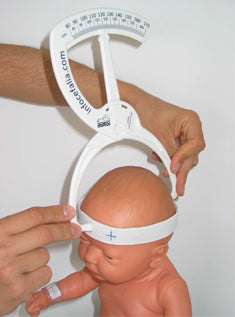Flat Head Syndrome
What is Flat Head (Positional Skull Deformities)
is the flattening of one or both sides of the head due to constant pressure on the skull.
It happens very quickly, especially in the first 3 months of life when the skull is still malleable and the head and brain are growing very fast.
During this time, baby spends long hours sleeping and lying on his back.
If baby’s head stays in the same position for long periods of time, with specific areas lying against a flat surface, then those parts of his skull may become flattened.
The positioning of the baby’s head is one of the main reasons for the appearance of these deformities

What causes a Flat Head?
Constant Positioning
When babies lying on their back with their head stay or turn to the same position constantly. E.g. in a pram, car seat, baby rocker, swing or activity mat.
Premature Baby
The skull of the premature infant is softer than a full term born baby.
They are more prone to positional plagiocephaly since they spend most of the time on their backs without being moved or picked up due to their medical needs and extreme fragility after birth.
Tortociolis (Wryneck)
is a "twisted neck”, a condition when the head is tilted to one side while the chin is turned to the other side. It is also called wryneck. The symptom can be detected during first 2-4 weeks.
More info can be found through this link: http://www.babycenter.com/0_torticollis_10912.bc

Multiple Births
Crowded room condition limit the movement on babies resulted in the same position for long.

What does a Flat Head look like?

Why is it a Problem?
In recent years, clinical studies have been done to investigate what long term effects might be associated with a diagnosis of head flattening and/or torticollis. More studies are being done to get more data and information, but current literature gives evidence that infant with plagiocephaly and/or torticollis may have other associated problems such as:
- A high risk for learning delays and developmental delay
- Increased need for special services when the child reaches school age
- Orthodontic and TMJ issues
- Scoliosis
- Visual disturbances including visual field defects, and astigmatism, auditory problems
- Psychological/social issues
Sources: http://www.flatheadprevention.org/about-flathead-syndrome/
Facial Asymmetry and Skull Shape Deformation
If baby flat head (deformational plagiocephaly) is not corrected early these undesirable craniofacial characteristics may grow into adulthood.
In the moderate to severe cases, there may be
- Eyes and ear misalignment,
- One cheek appears fuller than the other
- Forehead on the affected side is protruding

Does it Affect Brain Development?
An important study by Speltz and Collett, published in 2010 concluded that “Deformational plagiocephaly seems to be associated with early neurodevelopmental disadvantage, which is most evident in motor functions” This was followed up with their most recent study, which was published 2011 in July that stated ‘Toddlers with deformational plagiocephaly continue to exhibit developmental delays relative to toddlers without deformational plagiocephaly’.
Sources: Speltz ML, Collett BR, Stott-Miller M, Starr JR, Heike C, Wolfram-Aduan AM, King D, Cunningham ML. Case-control study of neurodevelopment in deformational plagiocephaly. Pediatrics. 2010 Mar; 125(3):e537-42

If you think your baby has a flat head, please check with your pediatrician, or get your baby’s head measure with CRANIOMETER. Specially designed measurement produced by MIMOSPILLOW for medical practioners.





